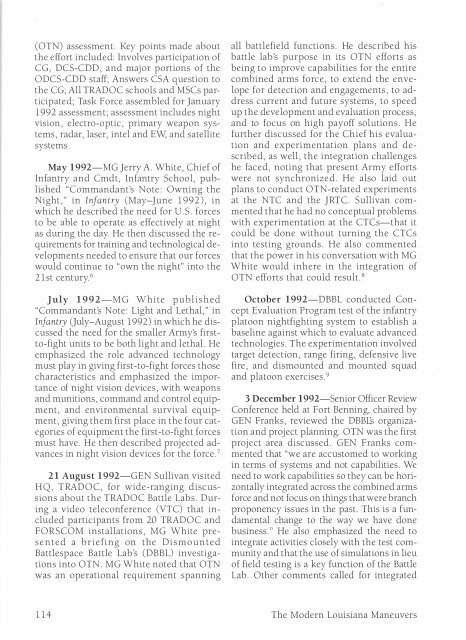The Modern Louisiana Maneuvers - US Army Center Of Military History
The Modern Louisiana Maneuvers - US Army Center Of Military History
The Modern Louisiana Maneuvers - US Army Center Of Military History
Create successful ePaper yourself
Turn your PDF publications into a flip-book with our unique Google optimized e-Paper software.
(OTN) assessment. Key points made about<br />
the effort included: Involves participation of<br />
CG, DCS-CDD, and major portions of the<br />
ODCS-CDD staff; Answers CSA question to<br />
the CG; All TRADOC schools and MSCs participated;<br />
Task Force assembled for January<br />
1992 assessment; assessment includes night<br />
vision, electro-optic, primary weapon systems,<br />
radar, laser, intel and EW, and satellite<br />
systems.<br />
May 1992-MG Jerry A. White, Chief of<br />
Infantry and Cmdt, Infantry School, published<br />
"Commandant's Note: Owning the<br />
Night," in Infantry (May-June 1992), in<br />
which he described the need for U.S. forces<br />
to be able to operate as effectively at night<br />
as during the day. He then discussed the requirements<br />
for training and technological developments<br />
needed to ensure that our forces<br />
would continue to "own the night" into the<br />
21st century6<br />
July 1992-MG White published<br />
"Commandant's Note: Light and Lethal," in<br />
Infantry (july-August 1992) in which he discussed<br />
the need for the smaller <strong>Army</strong>'s firstto-fight<br />
units to be both light and lethal. He<br />
emphasized the role advanced technology<br />
must play in giving first-to-fight forces those<br />
characteristics and emphasized the importance<br />
of night vision devices, with weapons<br />
and munitions, command and control equipment,<br />
and environmental survival equipment,<br />
giving them first place in the four categories<br />
of equipment the first-to-fight forces<br />
must have. He then described projected advances<br />
in night vision devices for the force.7<br />
21 August 1992-GEN Sullivan visited<br />
HQ, TRADOC, for wide-ranging discussions<br />
about the TRADOC Battle Labs. During<br />
a video teleconference (VTC) that included<br />
participants from 20 TRADOC and<br />
FORSCOM installations, MG White presented<br />
a briefing on the Dismounted<br />
Battlespace Battle Lab's (DBBL) investigations<br />
into OTN. MG White noted that OTN<br />
was an operational requirement spanning<br />
114<br />
all battlefield functions. He described his<br />
battle lab's purpose in its OTN efforts as<br />
being to improve capabilities for the entire<br />
combined arms force, to extend the envelope<br />
for detection and engagements, to address<br />
current and future systems, to speed<br />
up the development and evaluation process,<br />
and to focus on high payoff solutions. He<br />
further discussed for the Chief his evaluation<br />
and experimentation plans and described,<br />
as well, the integration challenges<br />
he faced, noting that present <strong>Army</strong> efforts<br />
were not synchronized. He also laid out<br />
plans to conduct OTN-related experiments<br />
at the NTC and the JRTC. Sullivan commented<br />
that he had no conceptual problems<br />
with experimentation at the CTCs-that it<br />
could be done without turning the CTCs<br />
into testing grounds. He also commented<br />
that the power in his conversation with MG<br />
White would inhere in the integration of<br />
OTN efforts that could result. 8<br />
October 1992-DBBL conducted Concept<br />
Evaluation Program test of the infantry<br />
platoon nightfighting system to establish a<br />
baseline against which to evaluate advanced<br />
technologies. <strong>The</strong> experimentation involved<br />
target detection, range firing, defensive live<br />
fire, and dismounted and mounted squad<br />
and platoon exercises 9<br />
3 December 1992-Senior <strong>Of</strong>ficer Review<br />
Conference held at Fort Benning, chaired by<br />
GEN Franks, reviewed the DBBl's organization<br />
and project planning. OTN was the first<br />
project area discussed. GEN Franks commented<br />
that "we are accustomed to working<br />
in terms of systems and not capabilities. We<br />
need to work capabilities so they can be horizontally<br />
integrated across the combined arms<br />
force and not focus on things that were branch<br />
proponency issues in the past. This is a fundamental<br />
change to the way we have done<br />
business." He also emphasized the need to<br />
integrate activities closely with the test community<br />
and that the use of simulations in lieu<br />
of field testing is a key function of the Battle<br />
Lab. Other comments called for integrated<br />
<strong>The</strong> <strong>Modern</strong> <strong>Louisiana</strong> <strong>Maneuvers</strong>
















